EDITORIAL: We are very glad to present you with another issue of Andon within four months of the previous one. If we can keep up this tempo we should be able to produce four issues every year. Wishful thinking ... I can hear you think, but you should realize that the editorial staff of Andon is small and that we largely depend on what our members offer for publication. Several years ago we adopted a reviewing procedure to guarantee and improve the quality of our bulletin. We know that some members are not pleased with this procedure. It means a lot of red tape for the editors and it retards publication considerably. Besides, some authors complain that referees might be opinionated and could try to frustrate the publication of unwelcome ideas. We have never experienced such practice but we can imagine that the procedure might frighten off potential authors. The editorial staff is of the opinion that quality shoud prevail. We would appreciate to hear your opinion about this reviewing procedure.
Eric van den Ing has joined the editorial board of Andon. He was a member of the Board of our Society for many years and he co-organized the successful Yoshitoshi exhibition. We hope to make use of his knowledge of Japanese prints and paintings. After this expansion of the editorial board we intend to pursue a more active policy of obtaining manuscripts. So don't be surprised when you get a letter from Eric asking for a contribution for Andon.
In the current issue the leading article is from the hand of John Fiorillo. He gives us another proof of his inquisitive mind. This time he has researched the origin and background of a group of Osaka chūban drawings attributed to Hirosada. I know that the manuscript did cost him a lot of work but in the end the result is worthwhile and I hope you will enjoy the article. The second contribution is from our new editor Eric van den Ing. Recently he acquired an interesting painting of mount Fuji. Like many of us he believed that Japanese paintings, unlike woodblock prints, were unique works of art until he discovered that from his Fuji probably a hundred very similar paintings do exist.










